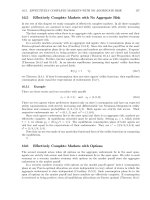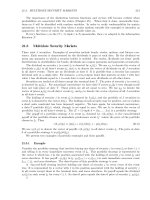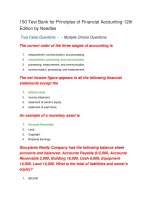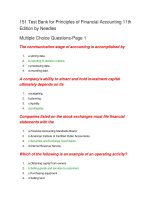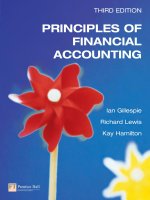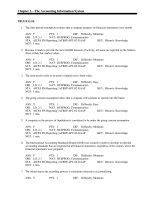Principles of financial engineering 3rd ed by robert l kosowkhi
Bạn đang xem bản rút gọn của tài liệu. Xem và tải ngay bản đầy đủ của tài liệu tại đây (28.18 MB, 893 trang )
Principles of Financial
Engineering
This page intentionally left blank
Principles of Financial
Engineering
Third Edition
Robert L. Kosowski
Oxford-Man Institute of Quantitative Finance
Oxford University
Salih N. Neftci
Department of Finance
Imperial College Business School
Imperial College London, UK
AMSTERDAM • BOSTON • HEIDELBERG • LONDON
NEW YORK • OXFORD • PARIS • SAN DIEGO
SAN FRANCISCO • SINGAPORE • SYDNEY • TOKYO
Academic Press is an imprint of Elsevier
Academic Press is an imprint of Elsevier
32 Jamestown Road, London NW1 7BY, UK
525 B Street, Suite 1800, San Diego, CA 92101-4495, USA
225 Wyman Street, Waltham, MA 02451, USA
The Boulevard, Langford Lane, Kidlington, Oxford OX5 1GB, UK
First published 2004
Second edition 2008
Third edition 2015
Copyright r 2015, 2008 and 2004 Elsevier Inc. All rights reserved.
No part of this publication may be reproduced or transmitted in any form or by any means, electronic or mechanical,
including photocopying, recording, or any information storage and retrieval system, without permission in writing
from the publisher. Details on how to seek permission, further information about the Publisher’s permissions policies
and our arrangements with organizations such as the Copyright Clearance Center and the Copyright Licensing Agency,
can be found at our website: www.elsevier.com/permissions.
This book and the individual contributions contained in it are protected under copyright by the Publisher
(other than as may be noted herein).
Notices
Knowledge and best practice in this field are constantly changing. As new research and experience broaden our
understanding, changes in research methods, professional practices, or medical treatment may become necessary.
Practitioners and researchers must always rely on their own experience and knowledge in evaluating and using
any information, methods, compounds, or experiments described herein. In using such information or methods
they should be mindful of their own safety and the safety of others, including parties for whom they have a
professional responsibility.
To the fullest extent of the law, neither the Publisher nor the authors, contributors, or editors, assume any liability
for any injury and/or damage to persons or property as a matter of products liability, negligence or otherwise, or
from any use or operation of any methods, products, instructions, or ideas contained in the material herein.
ISBN: 978-0-12-386968-5
British Library Cataloguing-in-Publication Data
A catalogue record for this book is available from the British Library
Library of Congress Cataloging-in-Publication Data
A catalog record for this book is available from the Library of Congress
For information on all Academic Press publications
visit our website at
Typeset by MPS Limited, Chennai, India
www.adi-mps.com
Printed and bound in the United States
Dedicated to
Salih Neftci and my family.
This page intentionally left blank
Contents
Preface to the Third Edition.............................................................................................................. xvii
CHAPTER 1
Introduction ................................................................................ 1
1.1 A Unique Instrument ..................................................................................................2
1.2 A Money Market Problem........................................................................................10
1.3 A Taxation Example.................................................................................................13
1.4 Some Caveats for What Is to Follow.......................................................................17
1.5 Trading Volatility .....................................................................................................18
1.6 Conclusions...............................................................................................................22
Suggested Reading ...........................................................................................................22
Exercises...........................................................................................................................22
CHAPTER 2
Institutional Aspects of Derivative Markets.................................. 25
2.1 Introduction...............................................................................................................26
2.2 Markets .....................................................................................................................26
2.3 Players.......................................................................................................................35
2.4 The Mechanics of Deals ...........................................................................................36
2.5 Market Conventions..................................................................................................39
2.6 Instruments................................................................................................................41
2.7 Positions ....................................................................................................................41
2.8 The Syndication Process...........................................................................................50
2.9 Conclusions...............................................................................................................51
Suggested Reading ...........................................................................................................51
Exercises...........................................................................................................................51
CHAPTER 3
3.1
3.2
3.3
3.4
3.5
3.6
3.7
3.8
3.9
Cash Flow Engineering, Interest Rate Forwards and Futures ......... 53
Introduction...............................................................................................................54
What Is a Synthetic?.................................................................................................55
Engineering Simple Interest Rate Derivatives.........................................................59
LIBOR and Other Benchmarks ................................................................................63
Fixed Income Market Conventions ..........................................................................64
A Contractual Equation ............................................................................................70
Forward Rate Agreements........................................................................................79
Fixed Income Risk Measures: Duration, Convexity and Value-at-Risk .................83
Futures: Eurocurrency Contracts..............................................................................89
vii
viii
Contents
3.10 Real-World Complications.....................................................................................95
3.11 Forward Rates and Term Structure ........................................................................96
3.12 Conventions ............................................................................................................98
3.13 A Digression: Strips ...............................................................................................99
3.14 Conclusions.............................................................................................................99
Suggested Reading .........................................................................................................100
Appendix—Calculating the Yield Curve.......................................................................100
Exercises.........................................................................................................................103
CHAPTER 4
Introduction to Interest-Rate Swap Engineering........................ 107
4.1 The Swap Logic....................................................................................................108
4.2 Applications ..........................................................................................................111
4.3 The Instrument: Swaps .........................................................................................115
4.4 Types of Swaps.....................................................................................................117
4.5 Engineering Interest-Rate Swaps .........................................................................124
4.6 Uses of Swaps.......................................................................................................133
4.7 Mechanics of Swapping New Issues....................................................................140
4.8 Some Conventions ................................................................................................144
4.9 Additional Terminology .......................................................................................145
4.10 Conclusions...........................................................................................................145
Suggested Reading .........................................................................................................145
Exercises.........................................................................................................................146
CHAPTER 5
Repo Market Strategies in Financial Engineering....................... 149
5.1 Introduction.............................................................................................................150
5.2 Repo Details............................................................................................................151
5.3 Types of Repo.........................................................................................................154
5.4 Equity Repos...........................................................................................................160
5.5 Repo Market Strategies ..........................................................................................161
5.6 Synthetics Using Repos ..........................................................................................168
5.7 Differences Between Repo Markets and the Impact of the GFC..........................170
5.8 Conclusions.............................................................................................................170
Suggested Reading .........................................................................................................171
Exercises.........................................................................................................................171
CHAPTER 6
6.1
6.2
6.3
6.4
Cash Flow Engineering in Foreign Exchange Markets................. 175
Introduction.............................................................................................................176
Currency Forwards .................................................................................................178
Synthetics and Pricing ............................................................................................183
A Contractual Equation ..........................................................................................184
Contents
ix
6.5 Applications ..........................................................................................................185
6.6 Conventions for FX Forward and Futures ...........................................................191
6.7 Swap Engineering in FX Markets ........................................................................194
6.8 Currency Swaps Versus FX Swaps......................................................................198
6.9 Mechanics of Swapping New Issues....................................................................204
6.10 Conclusions...........................................................................................................206
Suggested Reading .........................................................................................................207
Exercises.........................................................................................................................207
CHAPTER 7
Cash Flow Engineering and Alternative Classes
(Commodities and Hedge Funds)............................................... 211
7.1 Introduction.............................................................................................................212
7.2 Parameters of a Futures Contract ...........................................................................212
7.3 The Term Structure of Commodity Futures Prices ...............................................215
7.4 Swap Engineering for Commodities ......................................................................221
7.5 The Hedge Fund Industry.......................................................................................228
7.6 Conclusions.............................................................................................................233
Suggested Reading .........................................................................................................234
Exercises.........................................................................................................................234
CHAPTER 8
Dynamic Replication Methods and Synthetics Engineering ......... 237
8.1 Introduction.............................................................................................................238
8.2 An Example ............................................................................................................238
8.3 A Review of Static Replication..............................................................................239
8.4 “Ad Hoc” Synthetics...............................................................................................245
8.5 Principles of Dynamic Replication ........................................................................248
8.6 Some Important Conditions....................................................................................261
8.7 Real-Life Complications.........................................................................................262
8.8 Conclusions.............................................................................................................263
Suggested Reading .........................................................................................................264
Exercises.........................................................................................................................264
CHAPTER 9
9.1
9.2
9.3
9.4
9.5
9.6
Mechanics of Options .............................................................. 267
Introduction.............................................................................................................268
What Is an Option?.................................................................................................269
Options: Definition and Notation...........................................................................271
Options as Volatility Instruments...........................................................................277
Tools for Options....................................................................................................289
The Greeks and Their Uses ....................................................................................296
x
Contents
9.7 Real-Life Complications.........................................................................................309
9.8 Conclusion: What Is an Option? ............................................................................311
Suggested Reading .........................................................................................................311
Appendix 9.1 ..................................................................................................................311
Appendix 9.2 ..................................................................................................................313
Exercises.........................................................................................................................315
CHAPTER 10 Engineering Convexity Positions ............................................. 319
10.1 Introduction...........................................................................................................320
10.2 A Puzzle................................................................................................................320
10.3 Bond Convexity Trades........................................................................................321
10.4 Sources of Convexity ...........................................................................................334
10.5 A Special Instrument: Quantos ............................................................................340
10.6 Conclusions...........................................................................................................345
Suggested Reading .........................................................................................................346
Exercises.........................................................................................................................346
CHAPTER 11 Options Engineering with Applications..................................... 351
11.1 Introduction...........................................................................................................352
11.2 Option Strategies ..................................................................................................355
11.3 Volatility-Based Strategies...................................................................................367
11.4 Exotics ..................................................................................................................373
11.5 Quoting Conventions............................................................................................384
11.6 Real-World Complications...................................................................................387
11.7 Conclusions...........................................................................................................388
Suggested Reading .........................................................................................................388
Exercises.........................................................................................................................389
CHAPTER 12 Pricing Tools in Financial Engineering .................................... 393
12.1 Introduction...........................................................................................................394
12.2 Summary of Pricing Approaches .........................................................................395
12.3 The Framework ....................................................................................................396
12.4 An Application .....................................................................................................401
12.5 Implications of the Fundamental Theorem..........................................................408
12.6 Arbitrage-Free Dynamics .....................................................................................415
12.7 Which Pricing Method to Choose? ......................................................................419
12.8 Conclusions...........................................................................................................420
Suggested Reading .........................................................................................................420
Appendix 12.1: Simple Economics of the Fundamental Theorem ...............................420
Exercises.........................................................................................................................422
Contents
xi
CHAPTER 13 Some Applications of the Fundamental Theorem ...................... 427
13.1 Introduction...........................................................................................................428
13.2 Application 1: The Monte Carlo Approach.........................................................429
13.3 Application 2: Calibration....................................................................................438
13.4 Application 3: Quantos.........................................................................................448
13.5 Conclusions...........................................................................................................455
Suggested Reading .........................................................................................................455
Exercises.........................................................................................................................455
CHAPTER 14
Fixed Income Engineering ..................................................... 459
14.1 Introduction ........................................................................................................460
14.2 A Framework for Swaps ....................................................................................461
14.3 Term Structure Modeling...................................................................................471
14.4 Term Structure Dynamics ..................................................................................473
14.5 Measure Change Technology.............................................................................483
14.6 An Application ...................................................................................................488
14.7 In-Arrears Swaps and Convexity .......................................................................494
14.8 Cross-Currency Swaps .......................................................................................498
14.9 Differential (Quanto) Swaps ..............................................................................500
14.10 Conclusions ........................................................................................................501
Suggested Reading .........................................................................................................502
Exercises.........................................................................................................................502
CHAPTER 15 Tools for Volatility Engineering, Volatility Swaps,
and Volatility Trading............................................................. 507
15.1
15.2
15.3
15.4
15.5
15.6
15.7
Introduction...........................................................................................................508
Volatility Positions ...............................................................................................509
Invariance of Volatility Payoffs...........................................................................510
Pure Volatility Positions.......................................................................................518
Variance Swaps ....................................................................................................522
Real-World Example of Variance Contract.........................................................531
Volatility and Variance Swaps Before and After the GFC—
The Role of Convexity Adjustments?..................................................................531
15.8 Which Volatility? .................................................................................................539
15.9 Conclusions...........................................................................................................541
Suggested Reading .........................................................................................................542
Exercises.........................................................................................................................542
xii
Contents
CHAPTER 16
Correlation as an Asset Class and the Smile .......................... 545
16.1 Introduction to Correlation as an Asset Class ...................................................546
16.2 Volatility as Funding..........................................................................................551
16.3 Smile...................................................................................................................551
16.4 Dirac Delta Functions ........................................................................................552
16.5 Application to Option Payoffs ...........................................................................554
16.6 BreedenÀLitzenberger Simplified .....................................................................558
16.7 A Characterization of Option Prices as Gamma Gains.....................................561
16.8 Introduction to the Smile ...................................................................................562
16.9 Preliminaries.......................................................................................................563
16.10 A First Look at the Smile ..................................................................................564
16.11 What Is the Volatility Smile? ............................................................................565
16.12 Smile Dynamics .................................................................................................574
16.13 How to Explain the Smile..................................................................................574
16.14 The Relevance of the Smile...............................................................................582
16.15 Trading the Smile...............................................................................................583
16.16 Pricing with a Smile...........................................................................................583
16.17 Exotic Options and the Smile ............................................................................584
16.18 Conclusions ........................................................................................................588
Suggested Reading .........................................................................................................588
Exercises.........................................................................................................................588
CHAPTER 17 Caps/Floors and Swaptions with an Application to Mortgages ... 591
17.1 Introduction...........................................................................................................591
17.2 The Mortgage Market...........................................................................................592
17.3 Swaptions..............................................................................................................599
17.4 Pricing Swaptions .................................................................................................601
17.5 Mortgage-Based Securities...................................................................................607
17.6 Caps and Floors ....................................................................................................608
17.7 Conclusions...........................................................................................................613
Suggested Reading .........................................................................................................613
Exercises.........................................................................................................................613
CHAPTER 18 Credit Markets: CDS Engineering ............................................ 619
18.1
18.2
18.3
18.4
18.5
Introduction...........................................................................................................620
Terminology and Definitions ...............................................................................621
Credit Default Swaps ...........................................................................................623
Real-World Complications...................................................................................636
CDS Analytics ......................................................................................................640
Contents
xiii
18.6 Default Probability Arithmetic ..........................................................................641
18.7 Pricing Single-Name CDS .................................................................................646
18.8 Comparing CDS to TRS and EDS.....................................................................648
18.9 Sovereign CDS ...................................................................................................650
18.10 Conclusions ........................................................................................................655
Suggested Reading .........................................................................................................655
Exercises.........................................................................................................................655
CHAPTER 19 Engineering of Equity Instruments and Structural
Models of Default .................................................................. 659
19.1 Introduction...........................................................................................................660
19.2 What Is Equity? ....................................................................................................662
19.3 Equity as the Discounted Value of Future Cash Flows ......................................663
19.4 Equity as an Option on the Assets of the Firm ...................................................663
19.5 Capital Structure Arbitrage ..................................................................................673
19.6 Engineering Equity Products................................................................................680
19.7 Conclusions...........................................................................................................692
Suggested Reading .........................................................................................................692
Exercises.........................................................................................................................693
CHAPTER 20 Essentials of Structured Product Engineering........................... 695
20.1 Introduction...........................................................................................................696
20.2 Purposes of Structured Products ..........................................................................697
20.3 Structured Fixed-Income Products.......................................................................718
20.4 Some Prototypes ...................................................................................................724
20.5 Conclusions...........................................................................................................734
Suggested Reading .........................................................................................................734
Exercises.........................................................................................................................734
CHAPTER 21 Securitization, ABSs, CDOs, and Credit Structured Products...... 739
21.1
21.2
21.3
21.4
21.5
21.6
21.7
21.8
21.9
Introduction...........................................................................................................740
Financial Engineering of Securitization...............................................................740
ABSs Versus CDOs..............................................................................................745
A Setup for Credit Indices ...................................................................................750
Index Arbitrage.....................................................................................................754
Tranches: Standard and Bespoke .........................................................................756
Tranche Modeling and Pricing.............................................................................757
The Roll and the Implications..............................................................................762
Regulation, Credit Risk Management, and Tranche Pricing...............................764
xiv
Contents
21.10 New Index Markets ............................................................................................767
21.11 Structured Credit Products .................................................................................769
21.12 Conclusions ........................................................................................................776
Suggested Reading .........................................................................................................776
Exercises.........................................................................................................................777
CHAPTER 22 Default Correlation Pricing and Trading................................... 781
22.1 Introduction...........................................................................................................782
22.2 Two Simple Examples .........................................................................................782
22.3 Standard Tranche Valuation Model .....................................................................789
22.4 Default Correlation and Trading ..........................................................................795
22.5 Delta Hedging and Correlation Trading ..............................................................796
22.6 Real-World Complications...................................................................................799
22.7 Default Correlation Case Study: May 2005 ........................................................801
22.8 Conclusions...........................................................................................................804
Suggested Reading .........................................................................................................804
Appendix 22.1: Some Basic Statistical Concepts .........................................................805
Exercises.........................................................................................................................806
CHAPTER 23 Principal Protection Techniques ............................................. 809
23.1 Introduction.........................................................................................................809
23.2 The Classical Case..............................................................................................810
23.3 The CPPI.............................................................................................................811
23.4 Modeling the CPPI Dynamics............................................................................813
23.5 An Application: CPPI and Equity Tranches ......................................................815
23.6 Differences Between CPDO and CPPI ..............................................................820
23.7 A Variant: The DPPI ..........................................................................................821
23.8 Application of CPPI in the Insurance Sector: ICPPI.........................................822
23.9 Real-World Complications .................................................................................824
23.10 Conclusions ........................................................................................................825
Suggested Reading .........................................................................................................826
Exercises.........................................................................................................................826
CHAPTER 24 Counterparty Risk, Multiple Curves, CVA, DVA, and FVA ........... 827
24.1
24.2
24.3
24.4
24.5
Introduction...........................................................................................................827
Counterparty Risk.................................................................................................829
Credit Valuation Adjustment ...............................................................................831
Debit Valuation Adjustment.................................................................................842
Bilateral Counterparty Risk..................................................................................843
Contents
xv
24.6 Hedging Counterparty Risk................................................................................843
24.7 Funding Valuation Adjustment ..........................................................................845
24.8 CVA Desk...........................................................................................................846
24.9 Choice of the Discount Rate and Multiple Curves............................................847
24.10 Conclusions ........................................................................................................849
Suggested Reading .........................................................................................................849
Exercises.........................................................................................................................850
References.......................................................................................................................................... 851
Index .................................................................................................................................................. 857
This page intentionally left blank
Preface to the Third Edition
This book is an introduction. It deals with a broad array of topics that fit together through a certain
logic that we generally call Financial Engineering. The book is intended for beginning graduate
students and practitioners in financial markets. The approach uses a combination of simple graphs,
elementary mathematics, and real-world examples. The discussion concerning details of instruments, markets, and financial market practices is somewhat limited. The pricing issue is treated in
an informal way, using simple examples. In contrast, the engineering dimension of the topics under
consideration is emphasized.
Like Salih, I learned a great deal from technically oriented market practitioners who, over the
years, have taken my courses. The deep knowledge and the professionalism of these brilliant market professionals contributed significantly to putting this text together. I first met Salih at Hong
Kong University of Technology in 2006 where I gave a research seminar. Salih struck me as a very
knowledgable finance professional and charismatic teacher. It was with sadness that I learned of
Salih’s passing in 2009. I was asked to teach his course at HEC Lausanne in Switzerland in 2009
and 2010. I based the course on his Principles of Financial Engineering book, since I could relate
to the pedagogical approach in the book. I found the opportunity to revise the book for the third
edition a humbling and enjoyable experience. The world of financial engineering and derivatives
has changed significantly after the Global Financial Crisis (GFC) of 2008À2009 with a bigger
emphasis on simplicity, standardization, counterparty risk, central clearing, liquidity, and exchange
trading. But only 5 years after the GFC, new complex products such as contingent convertibles
(CoCos) have been sold by banks to investors and prices of risky assets are again at all time highs.
Understanding the principles of financial engineering can help us not only to solve new problems
but also to understand hidden risks in certain products and identify risky and inappropriate financial
engineering and market practices early enough to take action accordingly.
My main objective was to update the book and keep it topical by discussing how existing markets and market practices have changed and outline new financial engineering trends and products.
In 2009 and 2010, I served as specialist advisor to the UK House of Lords as part of their inquiries
into EU legislation related to alternative investment funds and Over-The-Counter (OTC) derivatives
and I have continued to follow regulatory changes affecting derivatives markets and alternative
investment funds with interest. I also benefitted greatly from my conversations with Marek Musiela
and Damiano Brigo on various topics included in the book. Several colleagues and students read
the original manuscript. I especially thank Damiano Brigo and Dimitris Karyampas and several
anonymous referees who read the manuscript and provided comments. The book uses several reallife episodes as examples from market practices. I would like to thank Thomson Reuters
International Financing Review (IFR), Derivatives Week (now part of GlobalCapital), Futuresmag,
Efinancialnews, Bloomberg and Risk Magazine for their kind permission to use the material.
I would like to thank Aman Kesarwani for excellent assistance with the creation of additional new
end-of-chapter exercises.
What is new in the third edition?
Financial engineering principles can be applied in similar ways to different asset classes and
therefore the third edition is structured in the form of different chapters on the application of
financial engineering principles to interest rates, currencies, commodities, credit, and equities.
xvii
xviii
Preface to the Third Edition
The material has been reorganized and streamlined. Since duration and related concepts are
referred to repeatedly in the book, a new section that introduces duration and other measures of
interest rate risk has been added to Chapter 3. The new Chapter 7 (on commodities and alternative investments) now contains a new expanded and updated section on the hedge fund industry
which has grown in importance in recent years. The section on commodities introduces the spotfutures parity theorem and applications such as the cash and carry arbitrage. A section on callable
bonds has been added to Chapter 16 (on option applications in fixed-income and mortgage markets). Chapter 18 on credit default swaps now contains material on CDS pricing and recent developments in sovereign CDS markets. In Chapter 19, the discussion of discounted cash flow
approaches to equity valuation has been replaced by a financial engineering perspective in the
form of the Merton model which views equity as an option on the firm’s assets. Reverse convertibles were added to the list of equity structured products discussed in Chapter 20. We introduce
securitization, ABS, CDOs in Chapter 21 and apply our financial engineering toolkit to the valuation and critical analysis of CoCos, a new post-GFC hybrid security. Chapter 22 discusses default
correlation trading including hedging and risk management of such positions. Market participants
and many academics were aware of the importance of counterparty risk before the GFC, but one
of the biggest revolutions in financial engineering and derivatives practice has been how comprehensively counterparty risk is now being incorporated into derivatives pricing. We no longer
assume as before that the counterparties in a derivatives transaction will honor their payment
obligations. Chapter 24 is one of the new chapters and deals with how counterparty risk adjustments such as CVA, DVA, and FVA affect the pricing of derivatives and the choice of the risk
free rate proxy.
All the remaining errors are, of course, mine. Solutions to the exercise and supplementary
material for the book will be available on the companion website. A great deal of effort went into
producing this book. Several more advanced issues that I could have treated had to be omitted, and
I intend to include these in the future editions.
Robert L. Kosowski
July 31, 2014
London
CHAPTER
INTRODUCTION
1
CHAPTER OUTLINE
1.1 A Unique Instrument..........................................................................................................................2
1.1.1 Buying a Default-Free Bond........................................................................................... 3
1.1.2 Buying Stocks .............................................................................................................. 5
1.1.3 Buying a Defaultable Bond ............................................................................................ 7
1.1.4 First Conclusions........................................................................................................ 10
1.2 A Money Market Problem ............................................................................................................... 10
1.2.1 The Problem .............................................................................................................. 11
1.2.2 Solution..................................................................................................................... 11
1.2.3 Some Implications...................................................................................................... 13
1.3 A Taxation Example........................................................................................................................ 13
1.3.1 The Problem .............................................................................................................. 14
1.3.1.1 Another strategy .....................................................................................................15
1.3.2 Implications............................................................................................................... 16
1.4 Some Caveats for What Is to Follow ................................................................................................ 17
1.5 Trading Volatility ........................................................................................................................... 18
1.5.1 A Volatility Trade ........................................................................................................ 20
1.5.2 Recap........................................................................................................................ 21
1.6 Conclusions................................................................................................................................... 22
Suggested Reading ............................................................................................................................... 22
Exercises ............................................................................................................................................. 22
Market professionals and investors take long and short positions on elementary assets such as
stocks, default-free bonds, and debt instruments that carry a default risk. There is also a great deal
of interest in trading currencies, commodities, and, recently, inflation, volatility, and correlation.
Looking from the outside, an observer may think that these trades are done overwhelmingly by
buying and selling the asset in question outright, for example, by paying “cash” and buying a US
Treasury bond. This is wrong. It turns out that most of the financial objectives can be reached in a
much more convenient fashion by going through a proper swap. There is an important logic behind
this and we choose this as the first principle to illustrate in this introductory chapter.
Principles of Financial Engineering.
Copyright © 2015 Elsevier Inc. All rights reserved.
1
2
CHAPTER 1 INTRODUCTION
1.1 A UNIQUE INSTRUMENT
First, we would like to introduce the equivalent of the integer zero, in finance. Remember the property of zero in algebra. Adding (subtracting) zero to any other real number leaves this number the
same. There is a unique financial instrument that has the same property with respect to market and
credit risk. Consider the cash flow diagram in Figure 1.1. Here, the time is continuous and the t0,
t1, t2 represent some specific dates. Initially we place ourselves at time t0. The following deal is
struck with a bank. At time t1 we borrow 100 US dollars (USD100), at the going interest rate of
time t1, called the LIBOR and denoted by the symbol Lt1 .1 We pay the interest and the principal
back at time t2. The loan has no default risk and is for a period of δ units of time.2 Note that the
contract is written at time t0, but starts at the future date t1. Hence this is an example of forward
contracts. The actual value of Lt1 will also be determined at the future date t1.
Now, consider the time interval from t0 to t1, expressed as tA[t0, t1]. At any time during this
interval, what can we say about the value of this forward contract initiated at t0?
It turns out that this contract will have a value identically equal to zero for all tA[t0, t1] regardless of what happens in world financial markets. Perceptions of future interest rate movements may
go from zero to infinity, but the value of the contract will still remain zero. In order to prove this
assertion, we calculate the value of the contract at time t0. Actually, the value is obvious in one
sense. Look at Figure 1.1. No cash changes hands at time t0. So, the value of the contract at time t0
must be zero. This may be obvious but let us show it formally.
To value the cash flows in Figure 1.1, we will calculate the time t1 value of the cash flows that
will be exchanged at time t2. This can be done by discounting them with the proper discount factor.
FIGURE 1.1
A forward loan.
1
The London Interbank Offered Rate (LIBOR) is the average interest rate reported by a group of banks in London for
borrowing from other banks. Traditionally LIBOR played a key role in financial engineering and derivatives pricing. As
we discuss in Chapter 4, during the Global Financial Crisis (GFC) LIBOR rose significantly due to increased counterparty risk. This and recent scandals surrounding LIBOR underreporting and manipulation have changed its role in derivatives pricing as discussed in Chapters 3 and 24.
2
The δ is measured in proportion to a year. For example, assuming that a “year” is 360 days and a “month” is always 30
days, a 3-month loan will give δ 5 1/4.
1.1 A UNIQUE INSTRUMENT
3
The best discounting is done using the Lt1 itself, although at time t0 the value of this LIBOR rate is
not known. Still, the time t1 value of the future cash flows are
PVt1 5
Lt1 δ 100
100
1
ð1 1 Lt1 δÞ ð1 1 Lt1 δÞ
(1.1)
At first sight, it seems we would need an estimate of the random variable Lt1 to obtain a numerical
answer from this formula. In fact, some market practitioners may suggest using the corresponding
forward rate that is observed at time t0 in lieu of Lt1 , for example. But a closer look suggests a
much better alternative. Collecting the terms in the numerator
PVt1 5
ð1 1 Lt1 δÞ100
ð1 1 Lt1 δÞ
(1.2)
the unknown terms cancel out and we obtain:
PVt1 5 100
(1.3)
This looks like a trivial result, but consider what it means. In order to calculate the value of the
cash flows shown in Figure 1.1, we don’t need to know Lt1 . Regardless of what happens to interest
rate expectations and regardless of market volatility, the value of these cash flows, and hence the
value of this contract, is always equal to zero for any tA[t0, t1]. In other words, the price volatility
of this instrument is identically equal to zero.
This means that given any instrument at time t, we can add (or subtract) the LIBOR loan to it,
and the value of the original instrument will not change for all tA[t0, t1]. We now apply this simple
idea to a number of basic operations in financial markets.
1.1.1 BUYING A DEFAULT-FREE BOND
For many of the operations they need, market practitioners do not “buy” or “sell” bonds. There is a
much more convenient way of doing business.
The cash flows of buying a default-free coupon bond with par value 100 forward are shown in
Figure 1.2. The coupon rate, set at time t0, is rt0 . The price is USD100, hence this is a par bond
and the maturity date is t2. Note that this implies the following equality:
100 5
rt0 δ 100
100
1
ð1 1 rt0 δÞ ð1 1 rt0 δÞ
(1.4)
which is true, because at t0, the buyer is paying USD100 for the cash flows shown in Figure 1.2.
Buying (selling) such a bond is inconvenient in many respects. First, one needs cash to do this.
Practitioners call this funding, in case the bond is purchased.3 When the bond is sold short it will
generate new cash and this must be managed.4 Hence, such outright sales and purchases require
inconvenient and costly cash management.
3
Following the GFC the issue of how to account for funding costs in valuing OTC derivatives has generated an intense
controversy. The arguments for and against the so-called FVA (funding value adjustment) will be discussed in Chapter 24.
4
Short selling involves borrowing the bond and then selling it. Hence, there will be a cash management issue.
4
CHAPTER 1 INTRODUCTION
FIGURE 1.2
Buying default-free bond.
Second, the security in question may be a registered bond, instead of being a bearer bond,
whereas the buyer may prefer to stay anonymous.
Third, buying (selling) the bond will affect balance sheets, called books in the industry.
Suppose the practitioner borrows USD100 and buys the bond. Both the asset and the liability sides
of the balance sheet are now larger. This may have regulatory implications.5
Finally, by securing the funding, the practitioner is getting a loan. Loans involve credit risk.
The loan counterparty may want to factor a default risk premium into the interest rate.6
Now consider the following operation. The bond in question is a contract. To this contract “add”
the forward LIBOR loan that we discussed in the previous section. This is shown in Figure 1.3a.
As we already proved, for all tA[t0, t1], the value of the LIBOR loan is identically equal to zero.
Hence, this operation is similar to adding zero to a risky contract. This addition does not change the
market risk characteristics of the original position in any way. On the other hand, as Figures 1.3a
and b show, the resulting cash flows are significantly more convenient than the original bond.
The cash flows require no upfront cash, they do not involve buying a registered security, and the
balance sheet is not affected in any way.7 Yet, the cash flows shown in Figure 1.3 have exactly the
same market risk characteristics as the original bond.
Since the cash flows generated by the bond and the LIBOR loan in Figure 1.3 accomplish the
same market risk objectives as the original bond transaction, then why not package them as a separate instrument and market them to clients under a different name? This is an interest rate swap
(IRS). The party is paying a fixed rate and receiving a floating rate. The counterparty is doing the
reverse.8 IRSs are among the most liquid instruments in financial markets.
5
For example, if this was an emerging market or corporate bond; the bank would be required to hold additional capital
against this purchase. Regulatory capital or capital requirement is the amount of capital a bank or other financial institution has to hold as required by its financial regulator.
6
If the Treasury security being purchased is left as collateral, then this credit risk aspect mostly disappears.
7
Here, for simplicity, we ignore potential cash flows related to margin requirements, discussed in Chapter 2, and adjustments related to counter-party risk such as CVA (credit valuation adjustment) and DVA (debit valuation adjustment),
discussed in Chapter 24.
8
By market convention, the counterparty paying the fixed rate is called the “payer” (while receiving the floating rate),
and the counterparty receiving the fixed rate is called the “receiver” (while paying the floating rate). The fixed rate payer
(floating rate payer) is often referred to as having bought (sold) the swap or having a long (short) position.
1.1 A UNIQUE INSTRUMENT
5
+100
(a)
+Lt0 δ100
t0
t1
t2
–100
+100
t0
t2
t1
–Lt1 δ100
–100
(b)
+st0 δ100
Add vertically
Received fixed
Interest t0
rate
swap
t1
t2
Pay floating
–Lt1 δ100
FIGURE 1.3
Engineering a simple IRS.
1.1.2 BUYING STOCKS
Suppose now we change the basic instrument. A market practitioner would like to buy a stock St at
time t0 with a t1 delivery date. We assume that the stock does not pay dividends. Hence, this is,
again, a forward purchase. The stock position will be liquidated at time t2. Also, assume that the
time t0 perception of the stock market gains or losses is such that the markets are demanding a price
St0 5 100
(1.5)
for this stock as of time t0. This situation is shown in Figure 1.4a, where ΔSt2 is the unknown stock
price appreciation or depreciation to be observed at time t2. Note that the original price being 100,
the time t2 stock price can be written as
St2 5 St1 1 ΔSt2
5 100 1 ΔSt2
Hence the cash flows shown in Figure 1.4a.
(1.6)
6
CHAPTER 1 INTRODUCTION
FIGURE 1.4
Engineering an equity or commodity swap.
It turns out that whatever the purpose of buying such a stock was, this outright purchase suffers
from even more inconveniences than in the case of the bond. Just as in the case of the Treasury
bond, the purchase requires cash, is a registered transaction with significant tax implications, and
immediately affects the balance sheets, which have regulatory implications. A fourth inconvenience
is a very simple one. The purchaser may not be allowed to own such a stock.9 Last, but not least,
there are regulations preventing highly leveraged stock purchases.
Now, apply the same technique to this transaction. Add the LIBOR loan to the cash flows
shown in Figure 1.4a and obtain the cash flows in Figure 1.4b. As before, the market risk characteristics of the portfolio are identical to those of the original stock. The resulting cash flows can be
9
For example, only special foreign institutions are allowed to buy Chinese A-shares that trade in Shanghai.


